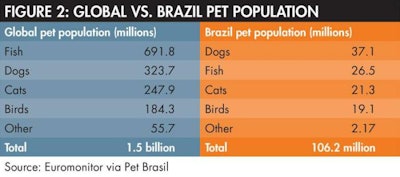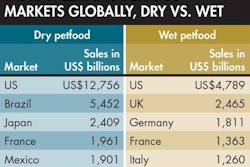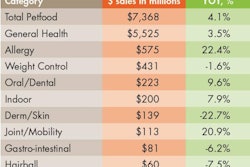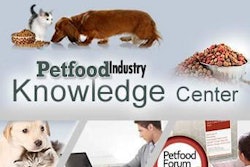
Emerging and developing global markets have caught the eye of the petfood industry in recent years, and rightly so. According to Euromonitor International, the gross domestic product (GDP) growth of emerging markets has far outstripped that of developed markets, increasing by roughly 5% in 2012 and 5.25% in 2013 compared to 1.25% growth in developed markets for those years. And while developed markets are expected to grow by roughly 2% annually through 2017, growth in emerging markets will remain over 5.5% each year.
Petfood and pet products have seen similar dominating growth in developing markets when compared to developed markets. While these two segments have mostly seen growth in developed markets since 2001 (barring a significant drop from 2009 to 2010—from 4% growth to roughly -1%—that the petfood industry is still regaining ground from), that growth has never gone beyond 4.5% per year.
In developing markets, however, the value of pet care has grown significantly each year, though the trend lines are far less predictable. The petfood market, for instance, saw 20% growth in 2001, then fell to roughly 12.5% in 2003, according to Euromonitor data. In 2004 it was back up to 18% growth, hit a low of 12% in 2009, and has been slowly increasing each year since then, to 14% in 2013.
Of the emerging markets, Latin America is garnering significant attention from the petfood industry. Not only is it the largest global developing market, it also contains one of the top ten pet care markets in the world (Brazil) and two of the leading markets in dry petfood (Brazil and Mexico). There is a particularly strong market for dog food in Latin America—approximately 75% of the region’s pet market is devoted to dog food, a higher percentage than any other global market, according to Euromonitor (see Figure 1).
Brazil held 8% of the global pet market in 2013 (second to the US, which held 28% of the market), and comes in fourth in a global pet population ranking (106.2 million pets in 2012). The country has 37.1 million dogs and 21.3 million cats (see Figure 2), a significant population for the petfood market to focus on. Brazil’s pet market bears that out, as more than half (53%) of the market’s US$8.23 billion value is devoted to petfood sales (see Figure 3). While a little over 50% of pets in Brazil still eat human food, that number is quickly decreasing as pets are being converted to commercial petfood.
According to Abinpet, the Brazilian pet products association, Brazil’s pet market is 31% of the country’s GDP, sixth after textiles, machinery, beauty/personal care items, telecom and electronics. That market is heavily focused on distribution: Of the 118,705 formal pet organizations in Brazil, 93% are involved in the distribution chain (wholesalers and distributors). The online petfood market has a presence in the country, particularly with dog food, and the physical pet retail options are diverse, including everything from small pet shops—which are highest in number but only carry 30% of petfood options on their shelves—to national mega stores, which carry 100% of Brazil’s petfood options.
With an increasingly diverse market and growing options for petfood suppliers looking to gain a foothold, it’s clear that Brazil makes a solid focus point for the petfood industry.
Mexico and Argentina are two other markets in Latin America particularly worth the petfood industry’s attention. Mexico is one of the leading markets in dry petfood (alongside the US, Brazil, Japan and France), according to Euromonitor. It’s also one of the three fastest-growing pet care markets overall, alongside Brazil and Russia, in spite of a 16% VAT increase applied to petfood resulting in price hikes. Mexico is set to see the second-largest increase in dog food value sales, contributing US$1 billion to the US$6 billion anticipated rise in global value sales over 2014–2019, according to Euromonitor.
Pet ownership is on the rise in Argentina, with 9 million dogs and 3 million cats currently making up the majority of pet owner profiles, according to Grupo Pilar Technical Manager Carlos Crosetti, DVM, PhD, who spoke at this year’s Petfood Forum. Although still developing, the petfood market in the country has taken in some of the trends being seen in larger markets, such as specialization and premiumization. Foods focusing on digestive health, immune system response (puppies), weight loss management, coat health/sensitive skin, joint health, urinary tract health, heart health and liver health are all areas of note for the growing market.
With multiple countries in the region already holding their own on the global petfood field, it’s no surprise that Latin America is the top emerging petfood market in the world. With nothing but growth on the horizon, it’s also one the industry should keep an eye on.


















